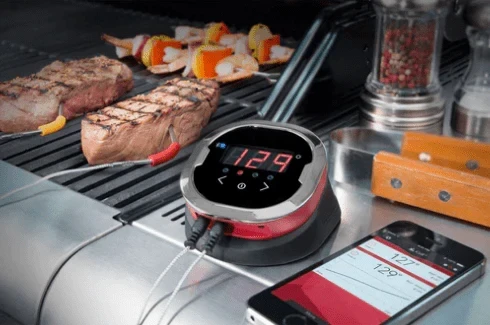Email format error
Email cannot be empty
Email already exists
6-20 characters(letters plus numbers only)
The password is inconsistent
Email format error
Email cannot be empty
Email does not exist
6-20 characters(letters plus numbers only)
The password is inconsistent


Meat Thermometer for Oven and Grill: Essential Tool for Perfectly Cooked Meals
When it comes to cooking meat to perfection, having the right tools is crucial. Among the most important of these tools is the meat thermometer for oven and grill. This handy device ensures that your meat is cooked to the ideal temperature, making it safe to eat and deliciously juicy. In this comprehensive guide, we will delve into the many benefits of using a meat thermometer, provide tips on selecting the best one for your needs, and offer step-by-step instructions on how to use it effectively for various types of meat, including how to use a meat thermometer for roast beef.
Why You Need a Meat Thermometer for Oven and Grill
Ensures Food Safety
One of the primary reasons to use a meat thermometer for oven and grill is to ensure food safety. Undercooked meat can harbor harmful bacteria like E. coli, Salmonella, and Listeria, which can cause serious illness. A meat thermometer helps you cook meat to the safe internal temperature recommended by food safety guidelines, thus reducing the risk of foodborne illnesses.
Enhances Flavor and Texture
Overcooking meat can lead to dry, tough, and flavorless results. On the other hand, perfectly cooked meat retains its juices, tenderness, and rich flavor. A meat thermometer allows you to achieve this perfection by providing precise temperature readings, so you know exactly when to take your meat off the heat.
Versatility in Cooking
Whether you're grilling steaks, roasting a whole chicken, or smoking ribs, a meat thermometer for oven and grill is versatile enough to handle it all. It can be used for a variety of cooking methods, ensuring that each type of meat is cooked to its best potential.
Types of Meat Thermometers
Instant-Read Thermometers
Instant-read thermometers provide quick and accurate temperature readings, usually within a few seconds. They are ideal for checking the temperature of thinner cuts of meat or for spot-checking different areas of a larger piece of meat.
Probe Thermometers
Probe thermometers have a probe that you insert into the meat, with a display that remains outside the oven or grill. This allows you to monitor the temperature without opening the oven or grill, helping to maintain a consistent cooking environment.
Wireless and Bluetooth Thermometers
For the tech-savvy cook, wireless and Bluetooth thermometers offer the convenience of monitoring your meat's temperature from a distance. These devices sync with your smartphone or tablet, providing real-time temperature updates and alerts.
How to Use a Meat Thermometer for Oven and Grill
General Tips
Calibrate Your Thermometer: Before using your meat thermometer for the first time, and periodically thereafter, ensure it is calibrated for accuracy. Follow the manufacturer's instructions for calibration.
Insert Correctly: Insert the thermometer into the thickest part of the meat, avoiding bones, fat, and gristle, which can give inaccurate readings.
Know Your Temperatures: Familiarize yourself with the recommended safe internal temperatures for different types of meat. For example, chicken should be cooked to 165°F (74°C), while beef steaks and roasts can be cooked to various levels of doneness, such as 145°F (63°C) for medium-rare.
How to Use a Meat Thermometer for Roast Beef
Roast beef is a classic dish that can be elevated to perfection with the use of a meat thermometer. Here's a step-by-step guide:
Preheat Your Oven: Preheat your oven to the desired temperature, typically around 350°F (175°C) for roast beef.
Prepare the Roast: Season your roast beef as desired. Insert the meat thermometer into the thickest part of the roast, ensuring it does not touch any bones.
Monitor the Temperature: Place the roast in the oven and monitor the temperature closely. For medium-rare roast beef, aim for an internal temperature of 135°F (57°C). Remove the roast from the oven when it is 5-10°F (3-6°C) below the desired temperature, as the meat will continue to cook while resting.
Rest the Meat: Allow the roast beef to rest for at least 15-20 minutes before slicing. This helps the juices redistribute throughout the meat, resulting in a more flavorful and tender roast.
Tips for Choosing the Best Meat Thermometer for Oven and Grill
Accuracy and Speed
When selecting a meat thermometer for oven and grill, accuracy and speed are paramount. Look for a thermometer that provides precise readings within a few seconds. This ensures you get an accurate temperature reading without losing too much heat by keeping the oven or grill open for too long.
Durability and Build Quality
Since a meat thermometer will be exposed to high temperatures and possibly rough handling, choose one made from durable materials. Stainless steel probes and heat-resistant cables are ideal for long-lasting performance.
User-Friendly Features
Features such as a large, easy-to-read display, backlighting for low-light conditions, and intuitive controls can make using a meat thermometer more convenient. Wireless and Bluetooth models with smartphone compatibility can add an extra layer of convenience, allowing you to monitor your meat from a distance.
Best Practices for Using a Meat Thermometer for Different Meats
Chicken
For whole chickens, insert the thermometer into the thickest part of the thigh, avoiding the bone. Chicken should reach an internal temperature of 165°F (74°C) to ensure it is safe to eat. For chicken breasts, insert the thermometer into the thickest part of the breast.
Pork
Insert the thermometer into the thickest part of pork chops, roasts, or tenderloins, avoiding bones. Pork should be cooked to an internal temperature of 145°F (63°C) and allowed to rest for three minutes before slicing and serving.
Fish
When cooking fish, insert the thermometer into the thickest part of the fillet. Fish should reach an internal temperature of 145°F (63°C) and should be opaque and flaky when done.
Maintenance and Care for Your Meat Thermometer
Cleaning
After each use, clean your meat thermometer thoroughly to prevent cross-contamination. Use warm, soapy water to clean the probe, and wipe down the display unit with a damp cloth. Avoid immersing the display unit in water.
Storage
Store your meat thermometer in a cool, dry place, away from direct sunlight and moisture. Some thermometers come with protective cases for safe storage.
Battery Maintenance
If your meat thermometer is battery-operated, check the batteries regularly and replace them as needed. Keeping spare batteries on hand ensures your thermometer is always ready for use.
Conclusion
A meat thermometer for oven and grill is an indispensable tool for any home cook or professional chef. It ensures your meat is cooked to the perfect temperature, enhancing both safety and flavor. By choosing the right type of thermometer, using it correctly, and maintaining it well, you can elevate your cooking skills and enjoy perfectly cooked meat every time.
Whether you're grilling, roasting, or smoking, a meat thermometer provides the precision and confidence needed to achieve culinary excellence. Invest in a high-quality meat thermometer today, and take the guesswork out of cooking delicious, safe, and perfectly cooked meat.

